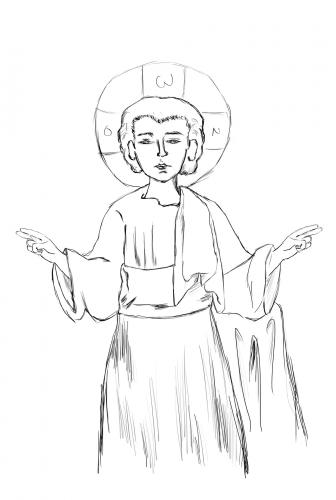



Iisus Emanuel
Semnificaţia numelor se referă la textul Evangheliei după Matei 1:20-23, unde, în scena Buneivestiri, Arhanghelul Gabriel o anunţă pe Fecioara Maria că va naşte un Fiu, care va purta numele Iisus (ebr. Yehoshua – “Mântuitorul”) şi Emanuel (ebr. Immanuel – “Cu noi este Domnul”). Numele Emanuel face referire versetul mesianic 7: 14 din Iasaia „Iată, fecioara va rămâne însărcinată, va naşte un Fiu şi-I va pune numele Emanuel”, interpretat de Biserică ca o prevestire a venirii lui Iisus.
Iconografic, Iisus Emanuel este reprezentat ca un adolescent imberb, văzut frontal, cu părul scurt şi buclat, îmbrăcat în tunică lungă peste care este drapat chitonul. Gestica de binecuvântare poate implica o mână sau amândouă. În jurul capului poartă nimbul cruciger, simbol al jertfei. Emanuel reprezintă unul din aspectele divine ale lui Iisus şi poate apărea astfel în multe teme, în special cele legate de taina euharistiei: în frescă în spaţiul altarului, în icoană sau în ilustraţia de carte, adeseori pe patenă, sau direct în pocalul euharistic. Poate apărea frecvent într-un simplu medalion circular.
Semnificaţia numelor se referă la textul Evangheliei după Matei 1:20-23, unde, în scena Buneivestiri, Arhanghelul Gabriel o anunţă pe Fecioara Maria că va naşte un Fiu, care va purta numele Iisus (ebr. Yehoshua – “Mântuitorul”) şi Emanuel (ebr. Immanuel – “Cu noi este Domnul”). Numele Emanuel face referire versetul mesianic 7: 14 din Iasaia „Iată, fecioara va rămâne însărcinată, va naşte un Fiu şi-I va pune numele Emanuel”, interpretat de Biserică ca o prevestire a venirii lui Iisus.
Iconografic, Iisus Emanuel este reprezentat ca un adolescent imberb, văzut frontal, cu părul scurt şi buclat, îmbrăcat în tunică lungă peste care este drapat chitonul. Gestica de binecuvântare poate implica o mână sau amândouă. În jurul capului poartă nimbul cruciger, simbol al jertfei. Emanuel reprezintă unul din aspectele divine ale lui Iisus şi poate apărea astfel în multe teme, în special cele legate de taina euharistiei: în frescă în spaţiul altarului, în icoană sau în ilustraţia de carte, adeseori pe patenă, sau direct în pocalul euharistic. Poate apărea frecvent într-un simplu medalion circular.




